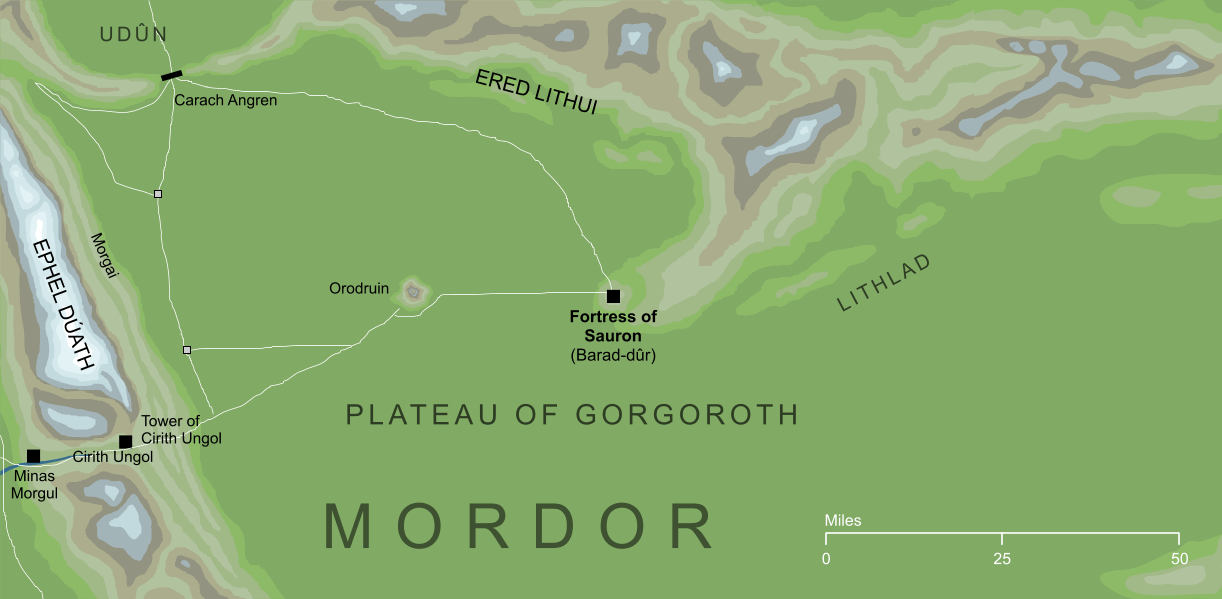The Encyclopedia of Arda - Fortress of Sauron (original) (raw)

The immense, Shadow-shrouded stronghold of Sauron within the Black Land of Mordor, more usually known as Barad-dûr, the Dark Tower. The Tower rose out of the Plateau of Gorgoroth, and was raised on an arm of rock that ran southwards from the Ashen Mountains that formed Mordor's northern frontier. Forged for the most part from dark metal, it was wreathed in concealing darkness and fumes, so that the structure of the Tower itself was rarely visible.
It was in about the year II 1000 that Sauron chose the land of Mordor as his dwelling-place in Middle-earth, and he soon began the building of a fortress there. Some six hundred years later, he made the One Ring in the Fire of Orodruin, and it was at this time that the Dark Tower reached its completion.1
The Barad-dûr served as the chief Fortress of Sauron for nearly two thousand years. It stood until the time of the War of the Last Alliance, a war begun by Sauron himself when he attempted to overrun the recently founded land of Gondor. The Gondorians rallied their fellow Dúnedain from the North-kingdom, as well as their allies the Elves, and eventually succeeded in defeating the Dark Lord. After their victory, the Fortress of Sauron was razed, but the power of the Ring meant that its foundations could not be completely destroyed.
For much of the Third Age that followed, the Gondorians held Mordor against Sauron's return, but eventually their power began to wane. Sauron established himself during this period in the lesser fortress of Dol Guldur, but when the time was right he returned to Mordor. The Fortress of Barad-dûr was rebuilt on its old foundations, and from it the Dark Lord threatened the Free Peoples of Middle-earth once again.
Unbreakable though the Fortress might have been, Sauron had reckoned without his lost Ring, failing to foresee that his enemies would seek to destroy it rather than claim it for themselves. During the War of the Ring, that Ring was indeed unmade. With its power lost, the foundations of the Fortress of Sauron were also broken, and the Dark Tower toppled into the dust of Gorgoroth.
Notes
| 1 | It surely cannot be coincidence that Sauron's Fortress was completed at about the same time that he made his Ruling Ring. Indeed, it is said that the Dark Tower's foundations were made with the power of the Ring, a statement that is difficult to square with the idea that the Fortress was begun six centuries earlier. This seems to imply that either Sauron must have somehow infused his power into the existing foundations, or that he abandoned his earlier works and raised a new Dark Tower after the Ring had been forged. A note quoted in Unfinished Tales hints at a third possible solution. In footnote 11 to the essay The Drúedain, Tolkien is quoted as mentioning '...Sauron's transference of power to the foundations of the Barad-dûr and to the Ruling Ring' (our italics). The implication here seems to be that the foundations of the tower were given a part of Sauron's power, but that power wasn't directly linked to the power held within the Ring. This helps to address the questions surrounding the historical timeline, though it raises some questions of its own. Most obviously: why, in this case, would Barad-dûr fall when the Ring was destroyed? We'd have to imagine a sort of chain reaction, whereby the unmaking of the Ring caused the Fall of Sauron, and that in turn caused the foundations of his Fortress to fail. |
|---|
Indexes:
About this entry:
- Updated 28 February 2022
- Updates planned: 1
For acknowledgements and references, see the Disclaimer & Bibliography page.
Original content © copyright Mark Fisher 2020, 2022. All rights reserved. For conditions of reuse, see the Site FAQ.